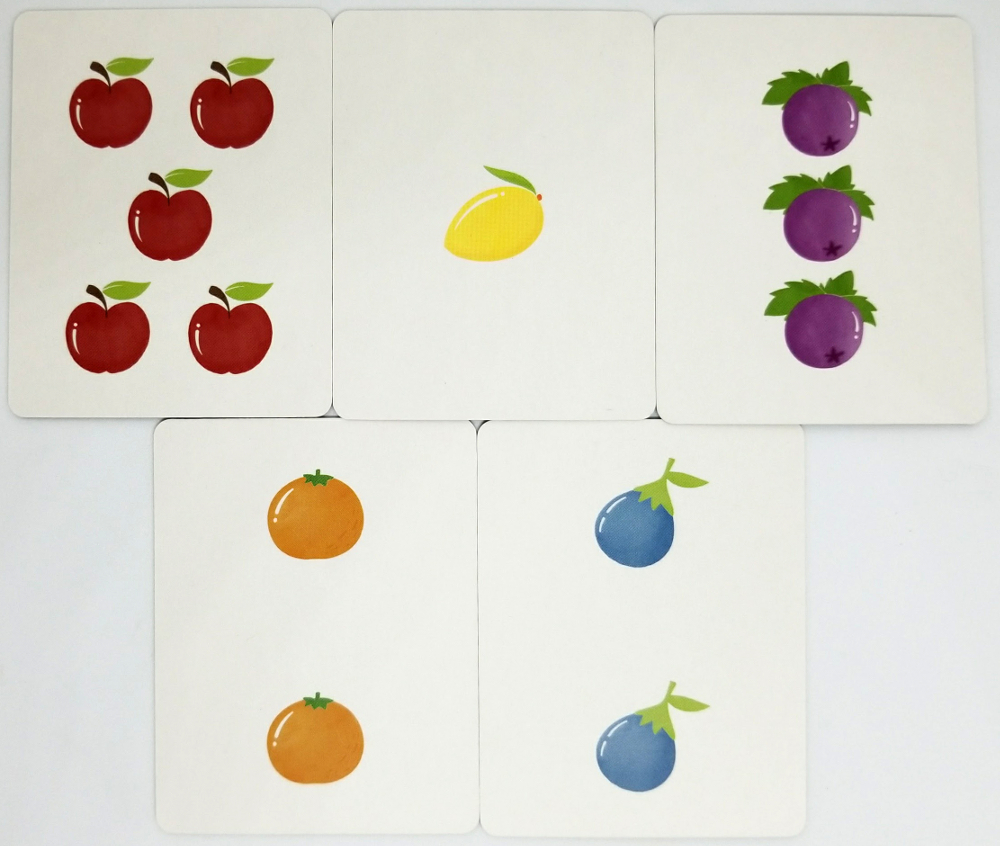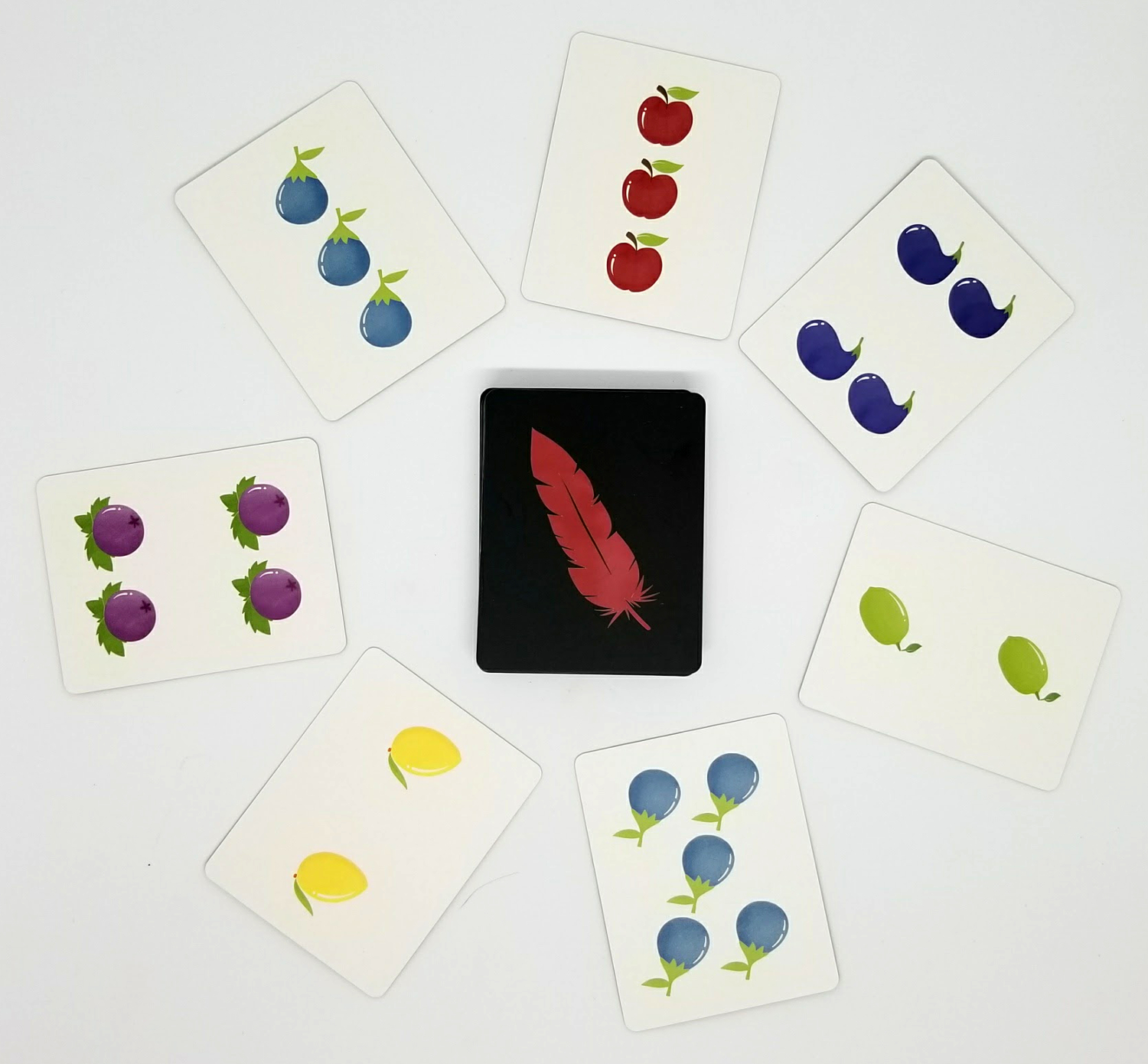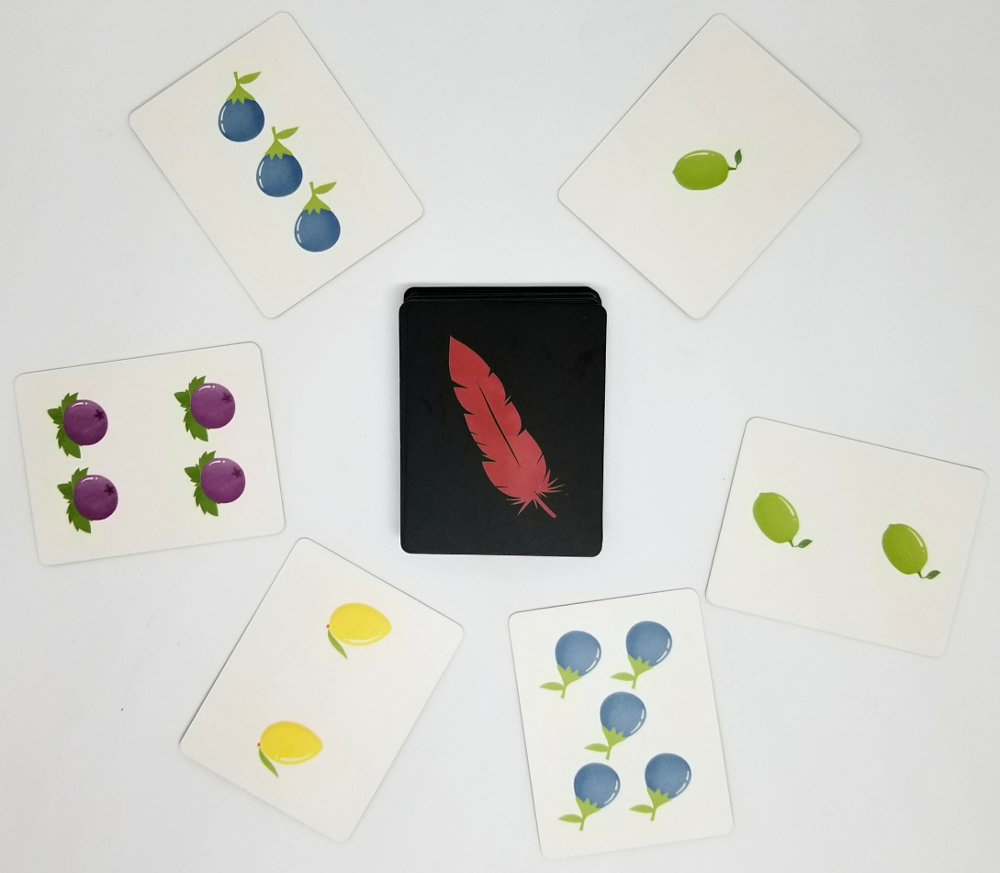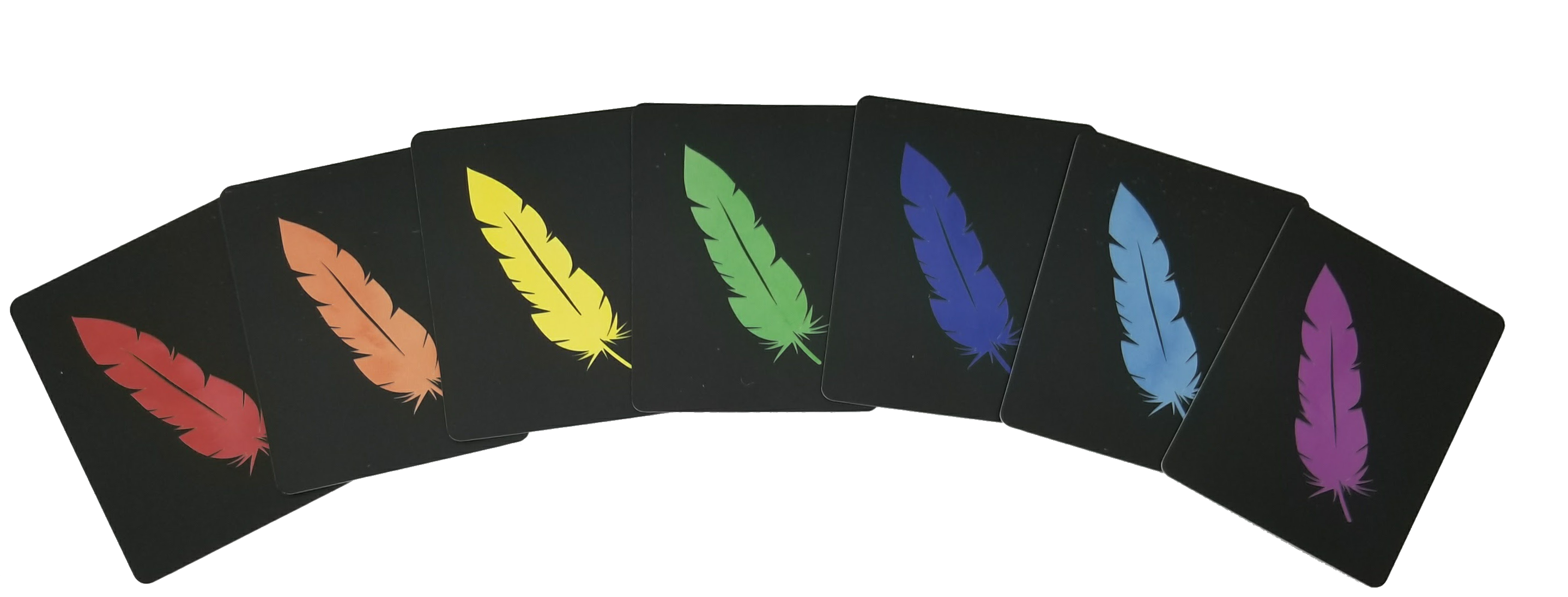Editor’s Note: This is a Rundown Review, a subset style of review that allows us to provide an Archetype breakdown on games when a normal comprehensive review isn’t possible or necessary. You can read more here for details.
The Overview
Once upon a time, all of the world’s birds were white, but that turned out to be a bit drab. Luckily, these ancestral birds had access to seven different colored fruits, and it was quickly learned that eating a specific fruit changed some of their feathers to change into that color. Realizing the prospect of what that meant, the race was on to become the first bird with the most pristine prismatic plumage.
In this quick and concise set collecting card game, each player begins with a hand of three Fruit cards. Each Fruit card reflects one of seven colors, matching both the depicted fruit on the front and feather on the back. In addition, the number of fruit icons on each card varies, with a range that fluctuates depending on the number of players. Seven more cards are then revealed in a circle around the deck. The last person who ate a fruit goes first.
On each player’s turn, their sole action is to play a card between two existing cards on the table. If the played card is equal to the difference in value between those two cards, they pick those two cards up. Otherwise, the player draws a single card from the bottom of the deck. If after drawing a player has more than seven cards in their hand, they must play cards to the board from among those they have more than one color of.
Turns continue in this manner until one player manages to arrange a hand of all seven colors. They immediately win the game and become the envy of all avian kind. Alternatively, should the deck run out beforehand, the player who has the most colors at that point is the winner instead.
The Rundown
 Architects: AVES is an exceedingly simple set collection game and one whose sole means of winning revolves around accumulating goods. In and of itself this is a style of gameplay that Architects typically enjoy. When paired with an extremely short play time and a hard limit on how many cards you can possess, however, AVES is the exception. The pursuit of needing to gather the necessary seven colored cards will appeal to them – but not the method for doing so. At best you can have a net gain of a single card each turn, but since you’re never able to hold more than seven at a time, this means that you’re constantly sacrificing one resource to attain another. And that zero-sum approach squarely goes against this group’s magpie-like tendencies.
Architects: AVES is an exceedingly simple set collection game and one whose sole means of winning revolves around accumulating goods. In and of itself this is a style of gameplay that Architects typically enjoy. When paired with an extremely short play time and a hard limit on how many cards you can possess, however, AVES is the exception. The pursuit of needing to gather the necessary seven colored cards will appeal to them – but not the method for doing so. At best you can have a net gain of a single card each turn, but since you’re never able to hold more than seven at a time, this means that you’re constantly sacrificing one resource to attain another. And that zero-sum approach squarely goes against this group’s magpie-like tendencies.

Tacticians: Tacticians flock to games that allow them to plan, adapt, and adjust to changing conditions over a sufficient period of time to achieve those plans. With an average play time of about 10 minutes and turns consisting of a single rote decision, AVES is, unsurprisingly, not a game for them. The choice of which card to play each turn has tactical merit, but the game has little in the way of actual strategy.
AVES can create a modicum more depth by incorporating optional Crow cards, however, and doing so is highly recommended as the standard. Crow cards have a value of zero, and the only way to get them out of your hand is to place them between two cards of the same value. Nor can you win while holding one. While few in number, Crows make the game slightly more interesting and dynamic as it gives you slightly more to think about.
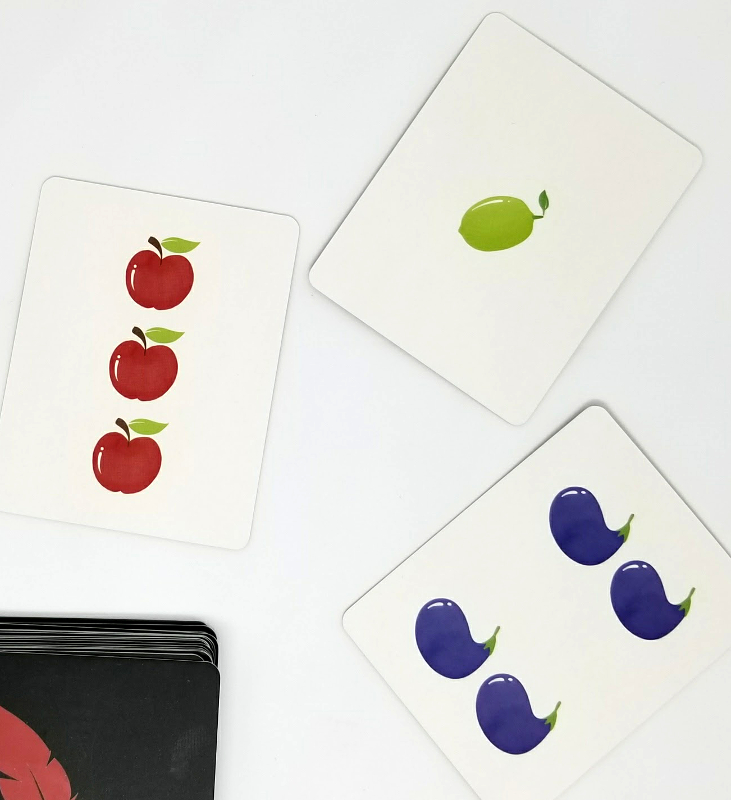
Because the player dropped a 1-value card – the difference between the two adjacent cards – they will pick up both Red and Indigo

Socializers: More than anything else, Socializers descend upon games where the focus is on player engagement over rules complexity, thematic depth, or even a highly focused degree of purpose. To this group, the social experience gained from interacting with their fellow players is paramount – regardless of whether that interaction is manufactured by in-game mechanics or is low-key and casual enough to foster conversation around the table whilst playing. To this group’s delight, AVES takes the latter approach. Eliciting an experience reminiscent of traditional card games, AVES has blisteringly short playthroughs, an incredibly lightweight pacing, and ruleset that can be taught in under a minute to anyone who understands basic colors and numbers, the combination of which provides a gameplay outlet while also freeing you up to socialize with your fellow players.

Daredevils: The bane of any game to Daredevils is one where they feel overly confined, unable to explore diverse strategies or experiment with different decisions just to see what happens. AVES is largely process-driven game, and as such, is the complete antithesis of what they find enjoyable in their gaming experience. Your only action is to play a card to the right spot in the hope of drawing two more in return, which they will find stifling, and while the game has a fair amount of randomness to it, it is deterministic rather than player driven. As a result, expect them to soar elsewhere, as AVES has neither the depth of choice or scope that this group enjoys.

Immersionists: This game is an abstract through and through. Immersionists don’t get excited much about games that, by definition, lack a cogent theme, and this one is no different. There’s little in the way of flavor in general, let alone to the degree this group prefers. The premise of AVES – birds eating colored fruits to alter their feather coat – is serviceable as context for the gameplay, but outside of the wonderful visual appeal of the box cover, there’s nothing to entice Immersionists. The artwork of the fruit cards is purely functional and are almost overshadowed by an over-abundance of white space, and the feathers only serve to convey what color cards you’re holding to other players. This all gives the game a rather rudimentary presentation. As an abstract that is tolerable. For those who crave visual appeal or thematic purpose? Not so much.

Strikers: With fast playthroughs and an incredibly concise purpose, it would initially seem like this would be a Striker-friendly game. However, attaining the goal of the glimmering prismatic hand is as much about pure chance as it is player decisions, largely thanks to a constantly changing board state and which cards you are able to draw. AVES is not devoid of player agency, but it is going to be way too ephemeral for this group’s liking.
This is compounded by the fact that AVES suffers from a turn order issue. Specifically, in 4-5 player games, the person going last has a statistical disadvantage that could hound them the entire game. Despite cyclical turns, if enough people can successfully claim two cards at a time beforehand, it can lead to getting caught in a loop of poor table options, making winning that much more challenging. Strikers will already be wary the degree to which luck affects your odds of winning, but knowing that seat position could be a factor too ensures they’ll be migrating away from this one.
The Takeaway
AVES is an unassuming game that flies highest when time and energy are in short supply, such as in between other activities or when you’d like to play something with mild player agency but that doesn’t require an abundance of focus or thought. AVES is paradoxically at its most rewarding when the game itself takes a back seat to the social engagement it promotes. Yet don’t construe this deference as a negative. For a 10 minute filler game with wide accessibility and far more replayability than it initially seems (especially if Crows are involved), AVES quietly and shrewdly accomplishes precisely what it means to.
It is not all a soaring success, however, as the game’s physical presentation leaves much to be desired. Considering AVES is effectively an abstract card game, the general component quality is serviceable but disappointing. Beyond the appealing prismatic feather backs, the overall appearance is lackluster, with tile-like cards that are awkwardly small in adult hands and whose underdeveloped front sides lack artwork or graphic design beyond rudimentary iconography, giving AVES an air of a game that’s all function and little form.
AVES is a product of Play With Us Design.
Cardboard Republic Snapshot Scoring (Based on scale of 5):
Artwork: 2
Rules Clarity: 3.5
Replay Value: 4
Physical Quality: 3
Overall Score: 3

